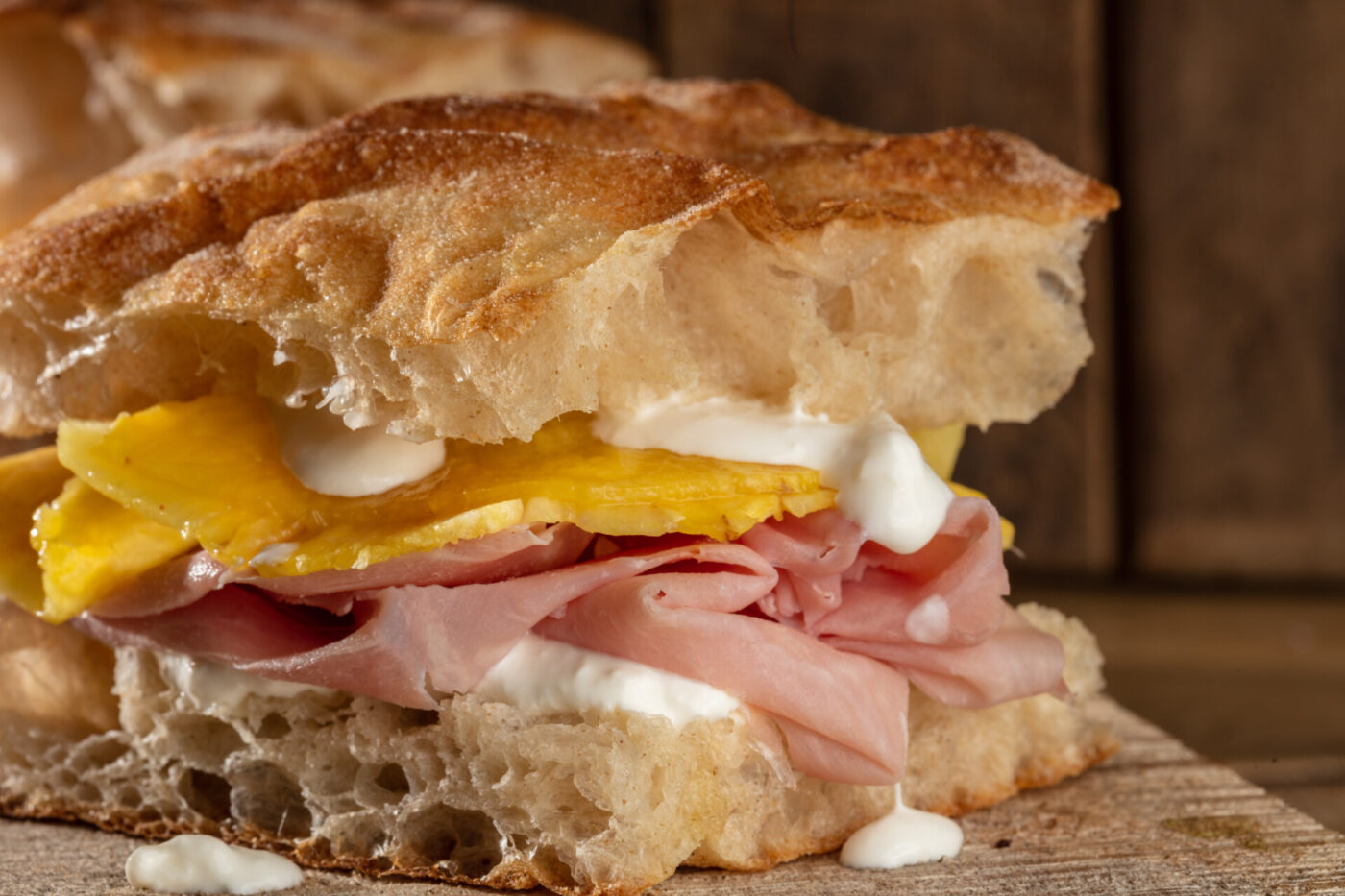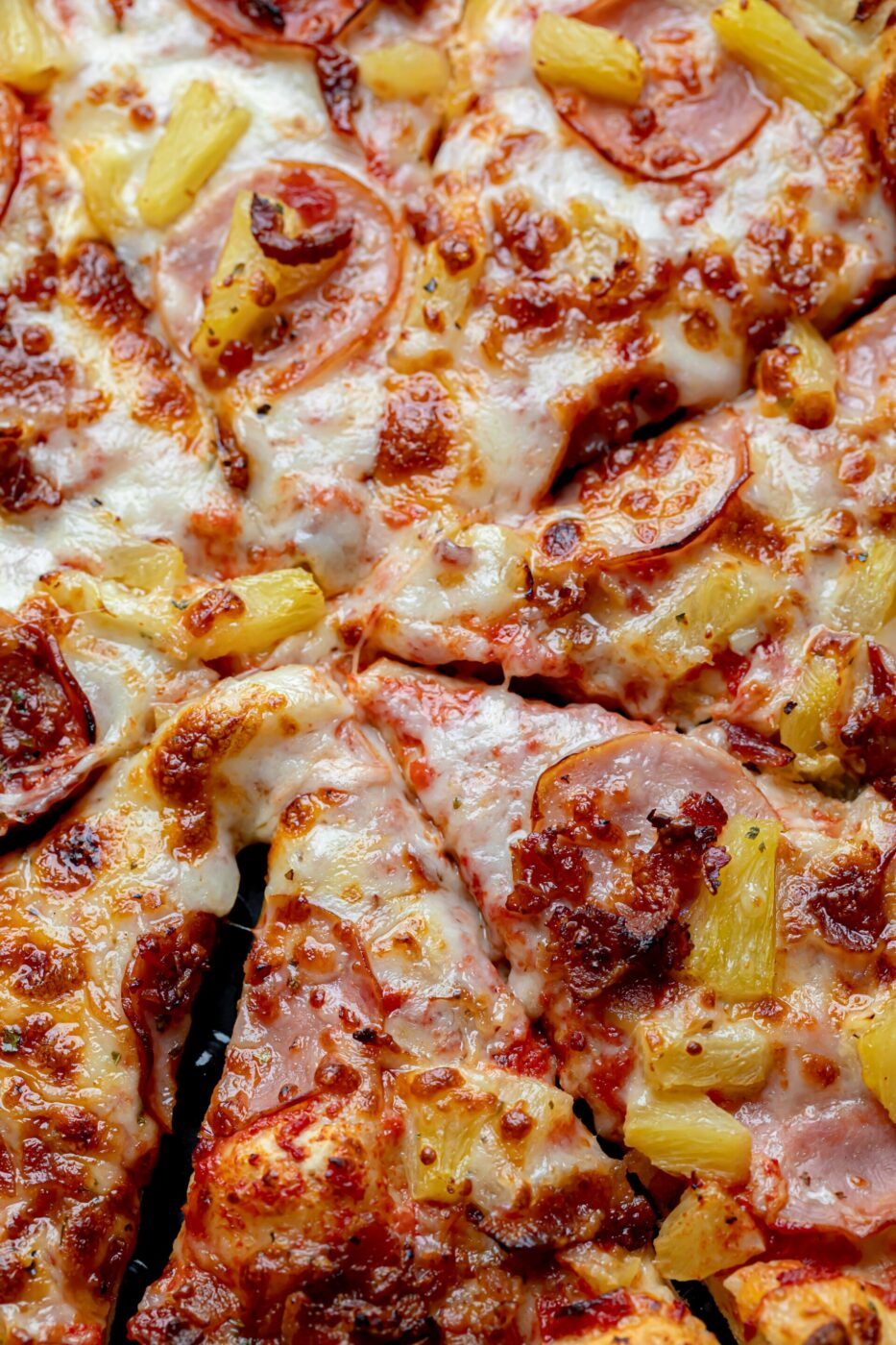If you get your il bel paese fix from the socials, take heed before believing every proselytism preached by the Italy “experts.” Don’t get me wrong, there are some thoughtful wanderlustful videos out there, but as someone who has lived in Italy for 11 years and counting, trust me when I say that plenty of the content misses the mark. On that account, I’m actually about to debunk one of the most prevalent gospels out there–it’s a biggie, so you might want to sit down: pineapple pizza isn’t inexistent in Italy. In fact, it’s (sort of) a thing here, and not only at tourist traps.
The cringiest crime against pizza is credited to Sam Panopoulos, who put a Hawaiian pie with tomatoes, mozzarella, pineapples, and ham on the menu at his Ontario pizzeria in 1962. In 2020, though, a graphic designer unearthed a 1957 Oregonian newspaper ad that questioned the topping’s completely Canadian provenance, publicizing a Portland pizzeria’s pineapple pie with papaya and green peppers. Nonetheless, the riff on Italy’s national dish undoubtedly hails from North America. But on the other side of the pond, even Italian pizzaioli who have held “three slices”, the highest rating possible from the Gambero Rosso guide, are flirting with the forbidden fruit.
Like Simone Lombardi, co-owner of Crosta, a Milan pizzeria and bakery that opened in 2018. The Padua native quasi-panicked when a Champagne house requested he prepare a pineapple pizza to pair with a wine for an event. So he downed two bottles of the divine bubbly, and then it hit home: his Mexican mother’s tacos al pastor recipe. Thus, his epic Ventricina pizza was born. Topped with its namesake Abruzzese sausage, roasted pineapples, spring onions, cilantro, and fior di latte, the pizza has won over the Milanesi and Italian food cognoscenti–it’s deemed a must-eat for anyone in town.
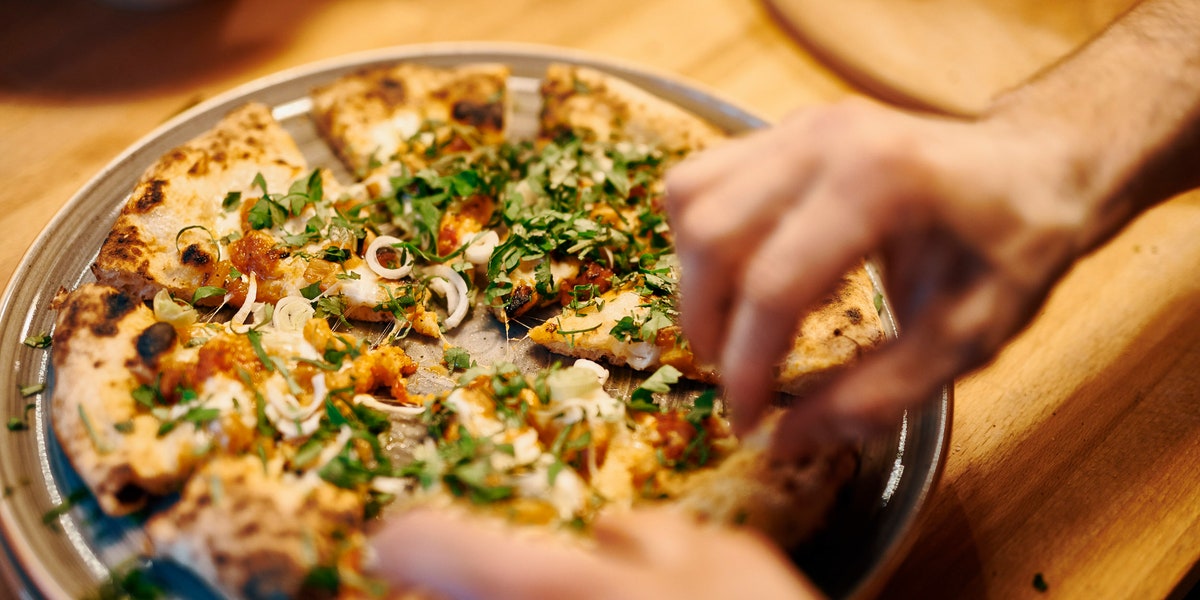
Pineapple-topped pizza at Crosta
Stefano Callegari of Rome’s Tonda tried pineapple pizza for the first time in New York in the late 1990s at an Italian-American joint. Though pleasantly surprised with the flavor, he didn’t add it to his repertoire until a 2017 social media interview challenged him to take on the taboo. His apizzacollananas combines spicy salami, Pecorino Romano flakes, and diced fresh pineapple, a “dry, savory, spicy topping” with the fruit adding a “pleasant sensation” evident at first bite. Few have refused to taste it, and those who do depart delighted.
In late 2016, Verona-based Renato Bosco crafted a pineapple filling for his “double crunch pizza” when planning for the Identità Golose chef congress. The pineapple pizza he sampled in Las Vegas in the late aughts sprang to mind for his presentation theme: Ogni viaggio ha i suoi frutti (every travel has its fruit). The recipe, crafted with input from his international staff, calls for vacuum sealing thinly sliced pineapples with mustard seeds that release their essence to the fruit, gently tempering its sweetness. He then stuffs it between two layers of soft-on-the-inside, crispy-on-the-outside dough alongside smoked provolone and prosciutto di Praga.

"Double crunch pizza" with pineapple by Renato Bosco; Photo by M. Magagna
Patrons brave enough to taste it certainly enjoy it, but Bosco admits it’s difficult to appeal to the average customer. “You have to find that customer willing to try new experiences,” he says, citing how the pizza sells better at the Milan offshoot of his Sapore pizzeria, which more foreigners frequent.
Myriad outlets, ranging from Italy’s 50 Top Pizza to America’s Food & Wine magazine, have proclaimed Franco Pepe’s Pepe in Grani pizzeria in Caiazzo the world’s best. Pepe, himself recently coined the world’s best pizzaiolo by the Best Pizza Awards 2024, entered the no-go area in 2019, tackling a challenge posed by a journalist in Hong Kong. For his AnaNascosta, an Italian portmanteau blending “hidden pineapple,” he conceals the fruit, shrouding it in a slice of San Daniele prosciutto. He then packs it into a fried pizza pocket slathered with a Grana Padano fonduta and finishes with a dusting of licorice powder. The staff withholds the details so the patrons can dig in bias-free–the secret ingredient isn’t revealed until they start gushing over its deliciousness.
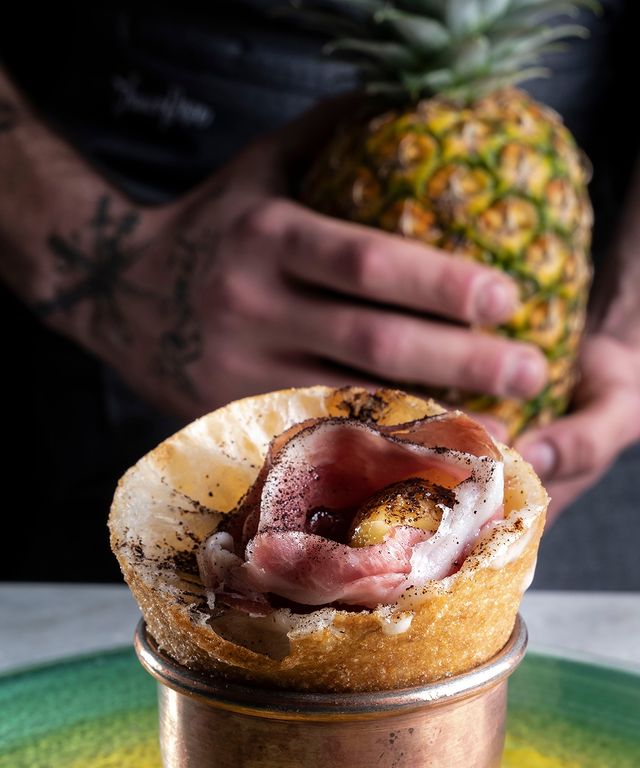
Fried pineapple cone; Courtesy of Pepe in Grani
Despite living in Los Angeles and Ventura, California, for six years, Gennaro Battiloro never availed himself of a Hawaiian pie. When visitors to his Battil’oro Fuochi + Lieviti + Spiriti in Querceta, Tuscany, started cheekily proposing he add the tropical topping to his margherita, he thought, why not? He approached the recipe so that it aligned with the ethos of his pizzeria: cocktail pairings. The result? The Camouflage pizza weaving a meticulous melange of artisanal fior di latte, Blue Stilton royal, Vermouth Chinato sauce, dehydrated Taggiasca olive powder, and pineapple gel. He’s fired up the pie for over two years and has no intention of eighty-sixing it. Instead, the enthusiastic response has inspired him to continue improving it. As for the cocktail coupling, it’s ultimately the guest’s choice, but he advises the Milano-Torino Bianco, an aperitivo mixing Campari and white vermouth.
In December, 2023, beloved Neapolitan pizzaiolo Gino Sorbillo shared his plans to serve the maligned fruit at his new establishment, Pizzeria Ostaria Presepe Napoletano, via a video that went viral. The pie embodies Sorbillo’s style, honoring Campania by complementing the double-cooked pineapples with ingredients like Monti Lattari smoked provola and shredded Cilento buffalo cacioricotta cheese coating the crust. Visitors to or dwellers of the Lombard capital can partake at his Milan Casa Sorbillo outpost.
Despite the efforts of the above and their peers, Italians are generally disgusted by the idea of Hawaiian-style pies. Yet, the nuances of ham and pineapple don’t differ drastically from those of common Italian combos like figs with salami, prosciutto with melon, speck with apples, and mortadella with grapes. So, why is the spiny fruit considered so repulsive?
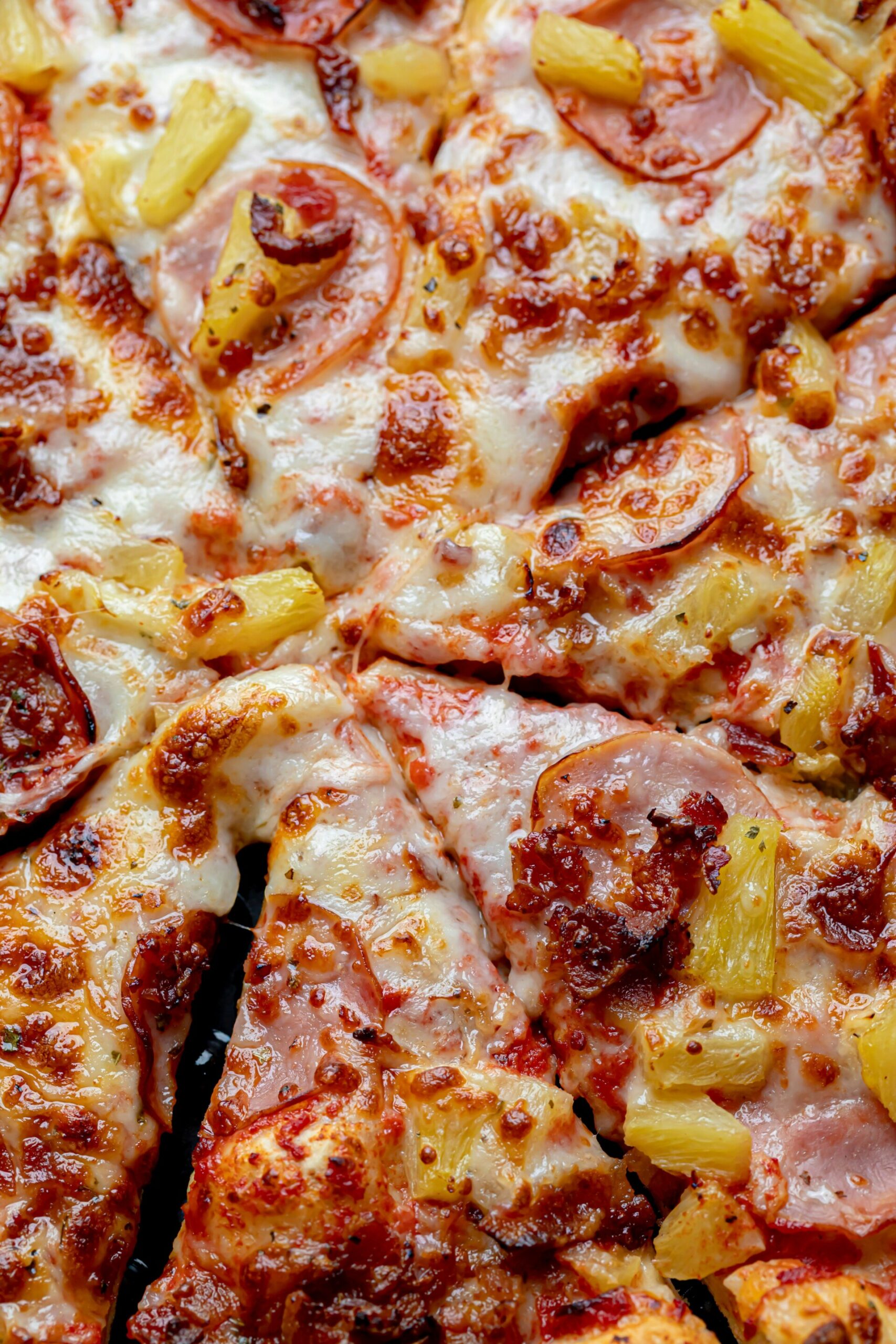
To start, pineapple is not native. Bosco, born in the late 1960s, explains that his generation’s first encounter with the fruit was a syrupy, cloying canned concoction that embedded a not-so-fond memory, rendering his age group less amenable to pineapple pizza than, say, that of his 17-year-old son. For those not keen on sweet and savory in the same bite, he posits that the duo becomes even more disdainful when it involves pineapple.
Callegari contends that tradition also factors in, which pizza and simplicity have always exemplified, so such a sweet, exotic topping is considered heretical: “it’s like putting ketchup on spaghetti.”
As for tradition, Battiloro is rather fond of defying it. He admits that Italians are exceptionally serious about pizza, leading to closed-mindedness and little flexibility. He believes “everything is good and interesting if done thoughtfully,” especially when it tells a story.
Gabriele Zanatta, an Italian food journalist and Editor in Chief of the Identità Golose restaurant guidebook, agrees. He doesn’t understand why pineapple is such a divisive topping. “It should be treated like any other ingredient in the kitchen, and it shouldn’t make any other difference.”
While pineapple’s non-native origins may repel Italians, he mentions how, in recent years, farmers have started cultivating the fruit near Palermo as Sicily has grown more tropical due to climate change.
“In Italy, it’s always like this,” he states. “Tradition is often a hole that prevents us from cooking new things, and it grows unjustified prejudices, but we always have to keep our sensitivities open to the unexpected.” He points out how non-native ingredients comprise Italy’s most emblematic dish: spaghetti with tomatoes and basil. Spaghetti comes from Mesopotamia, the cradle of grain; basil originated in Southeast Asia; and tomatoes arrived from Latin America.
“If we hadn’t had an open attitude, we would never have had our most recognizable dish. And the same goes for pizza.” Zanatta believes anything is possible in the kitchen, but indicates that someone who understands flavor should handle pineapple because mingling it with tomatoes can produce harsh acidity.
Italy admirers tend to warp its culture into a romanticized mold shaped by their preconceived ideas. It’s no secret that Italians have a reputation as staunch traditionalists–in some ways, they are, and they’re all the better for it. But innovation abounds in Italy. The food is markedly more imaginative than the socials suggest–just attune your eyes and minds to seek the unforeseen.
As for confronting taboos, everyone has a limit. I draw the line at spaghetti with ketchup.

